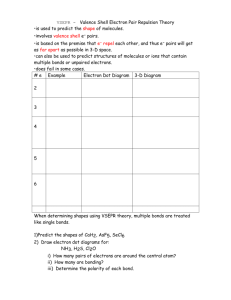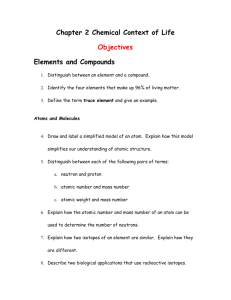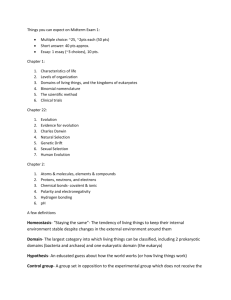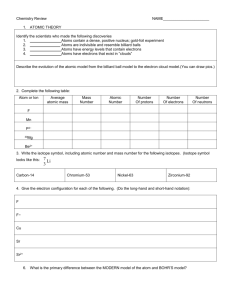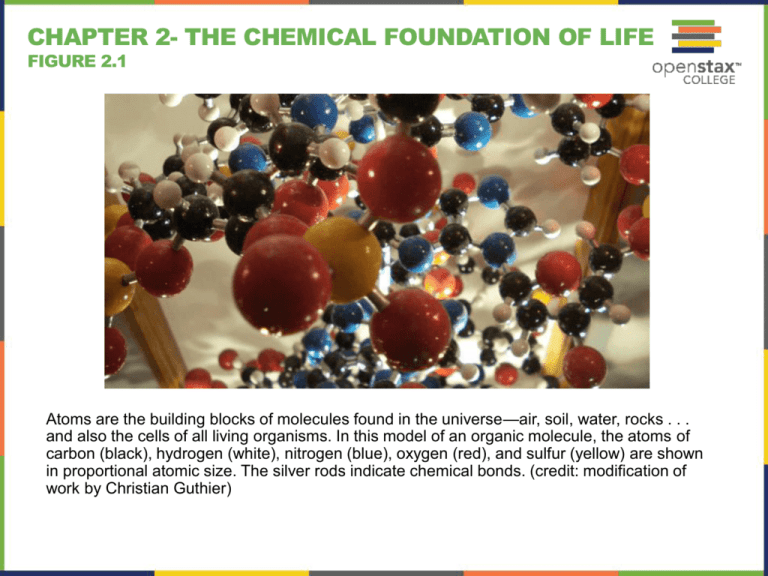
CHAPTER 2- THE CHEMICAL FOUNDATION OF LIFE
FIGURE 2.1
Atoms are the building blocks of molecules found in the universe—air, soil, water, rocks . . .
and also the cells of all living organisms. In this model of an organic molecule, the atoms of
carbon (black), hydrogen (white), nitrogen (blue), oxygen (red), and sulfur (yellow) are shown
in proportional atomic size. The silver rods indicate chemical bonds. (credit: modification of
work by Christian Guthier)
Matter is any substance that occupies space and has mass.
Elements are unique forms of matter with specific chemical and physical
properties that cannot be broken down into smaller substances by ordinary
chemical means.
PERCENTAGE OF ELEMENTS
Most Abundant Chemical Elements, by Mass
Earth’s Crust
Oceans
Earth’s Core
Air
Organisms
Oxygen 50%
Oxygen 88%
Iron >80%
Nitrogen 78%
Oxygen 65%
Silicon 26%
Hydrogen 11%
Nickel 4%
Oxygen 21%
Carbon 19%
Aluminum 7%
Chlorine 2%
Other
Argon 1%
Hydrogen 10%
Iron 5%
Sodium 1%
Other
Nitrogen 3%
Other
Other
Other
STRUCTURE OF AN ATOM
Elements are made up of atoms.
Atoms are made up of protons(+,1 amu) and neutrons(0,
1 amu) located within the nucleus, with electrons(-, 0
amu) in orbitals surrounding the nucleus.
ATOMIC NUMBER AND MASS
Atomic number is the number of protons
Mass number is the number of proton and neutrons
Isotopes of an element that have the same atomic number, but a
different number of neutrons. Therefore this mass number is different.
Some isotopes are radioactive and “decay” as they shed particles.
Atomic mass is mean of the naturally occurring masses, due to
isotopes
CARBON DATING
The radiocarbon dating method is based on the fact that radiocarbon is constantly being created
in the atmosphere by the interaction of solar radiation with atmospheric nitrogen. The resulting radiocarbon
combines with atmospheric oxygen to form radioactive CO2, which is incorporated into plants; animals then
acquire 14C by eating the plants. When the animal or plant dies, it stops exchanging carbon with its
environment, and from that point onwards the amount of 14C it contains begins to reduce as the 14C
undergoes radioactive decay. Measuring the amount of 14C in a sample from a dead plant
or animal such as piece of wood or a fragment of bone provides information that can be used to calculate
when the animal or plant died. The older a sample is, the less 14C there is to be detected, and because the
half-life of 14C (the period of time after which half of a given sample will have decayed) is about 5,730 years,
the oldest dates that can be reliably measured by radiocarbon dating are around 50,000 years ago, although
special preparation methods occasionally permit dating of older samples.
The age of carboncontaining remains less than
about 50,000 years old, such
as this pygmy mammoth,
can be determined using
carbon dating. (credit: Bill
Faulkner, NPS)
FIGURE 2.5
The periodic table shows the atomic mass and atomic number of each element. The
atomic number appears above the symbol for the element and the approximate atomic
mass appears below it.
FIGURE 2.6
The Bohr model was developed by Niels Bohrs in 1913. In this model, electrons exist within
principal shells. An electron normally exists in the lowest energy shell available, which is the
one closest to the nucleus. Energy from a photon of light can bump it up to a higher energy
shell, but this situation is unstable, and the electron quickly decays back to the ground state.
In the process, a photon of light is released.
The innermost shell (1n) holds 2 electrons
The next (2n) and outermost shell (3n) holds 8 electrons
Valence Shell is the title for the outermost shell of electrons
Nobel Gases have their valence electron orbitals filled and are considered inert
because they are non-reactive.
FIGURE 2.7
Bohr diagrams indicate how many electrons fill each principal shell. Group 18 elements
(helium, neon, and argon are shown) have a full outer, or valence, shell. A full valence shell is
the most stable electron configuration. Elements in other groups have partially filled valence
shells and gain or lose electrons to achieve a stable electron configuration.
ELECTRON ORBITALS
FIGURE 2.8
The s subshells are shaped like spheres. Both the 1n and 2n principal shells have an s
orbital, but the size of the sphere is larger in the 2n orbital. Each sphere is a single
orbital. p subshells are made up of three dumbbell-shaped orbitals. Principal shell 2n
has a p subshell, but shell 1 does not.
1n= s
2n= s+p
3n= s+p+d
TYPES OF BONDS- IONIC BONDS
Ions form when an atom gains or loses an electron
• Cation are positive, lost an electron
• Anion are negative, gained an electron
Ionic bonds form between ions of opposite charges. Usually between
a metal (lose an electron) and a nonmetal (gain an electron).
CHEMICAL REACTIONS AND MODELS
FIGURE 2.9
Two or more atoms may bond with each other to form a molecule. When two hydrogens
and an oxygen share electrons via covalent bonds, a water molecule is formed.
COVALENT BONDS
FIGURE 2.12
Covalent Bonds form when atoms share electrons to fill valence shells.
- Polar bonds form when electrons are not shared equally
- Nonpolar bonds form when electrons are shared equally
Whether a molecule is polar or
nonpolar depends both on bond
type and molecular shape. Both
water and carbon dioxide have
polar covalent bonds, but carbon
dioxide is linear, so the partial
charges on the molecule cancel
each other out.
WEAK BONDS
Ionic and Covalent bonds require energy to break. Two weaker
bonds are:
- van der Waals interactions
- Hydrogen bonds
WATER
Water is a polar molecule which forms hydrogen bonds with other
nearby water molecules.
PROPERTIES OF WATER
Polar
- Hydrophillic- a substance that interacts with or dissolves in water
- Hydrophobic- a substance that does not interact with water
- Solvent- a substance capable of dissolving other molecules
High Specific Heat Capacity- for one gram of water it takes one calorie of
energy to raise the temperature one degree
- Water heats and cools slowly
Adhesion- attraction to other molecules
- Capillary action
Cohesion- attraction of water to itself
- Surface tension
FIGURE 2.13
Oil and water do not mix. As this macro image of oil and water shows, oil does not
dissolve in water but forms droplets instead. This is due to it being a nonpolar
compound. (credit: Gautam Dogra).
FIGURE 2.14
Hydrogen bonding makes ice less dense than liquid water. The (a) lattice structure of ice
makes it less dense than the freely flowing molecules of liquid water, enabling it to (b) float on
water. (credit a: modification of work by Jane Whitney, image created using Visual Molecular
Dynamics (VMD) software [1]; credit b: modification of work by Carlos Ponte)
FIGURE 2.15
When table salt (NaCl) is mixed in water, spheres of hydration are formed around the
ions.
FIGURE 2.16
The weight of the needle is pulling the surface downward; at the same time, the surface
tension is pulling it up, suspending it on the surface of the water and keeping it from
sinking. Notice the indentation in the water around the needle. (credit: Cory Zanker)
FIGURE 2.17
Capillary action in a glass tube is caused
by the adhesive forces exerted by the
internal surface of the glass exceeding
the cohesive forces between the water
molecules themselves. (credit:
modification of work by Pearson-Scott
Foresman, donated to the Wikimedia
Foundation)
FIGURE 2.18
Water’s cohesive and adhesive properties allow this water strider (Gerris sp.) to stay
afloat. (credit: Tim Vickers)
FIGURE 2.19
The pH scale measures the
concentration of hydrogen ions (H+) in a
solution. (credit: modification of work by
Edward Stevens)
BUFFERS
FIGURE 2.20
Buffers absorb excess H+ or OH-
This diagram shows the body’s buffering of blood pH levels. The blue arrows show the
process of raising pH as more CO2 is made. The purple arrows indicate the reverse
process: the lowering of pH as more bicarbonate is created.
HYDROCARBONS
Hydrocarbons consists of only hydrogen and carbon.
- aliphatic hydrocarbons linear carbon chains
- aromatic hydrocarbons closed ring structures
FIGURE 2.22
When carbon forms single bonds with other atoms, the shape is tetrahedral. When two
carbon atoms form a double bond, the shape is planar, or flat. Single bonds, like those
found in ethane, are able to rotate. Double bonds, like those found in ethene cannot
rotate, so the atoms on either side are locked in place.
-ane single bond
-ene double bond
-yne triple bond
FIGURE 2.23
Carbon can form five-and six membered rings. Single or double bonds may connect the
carbons in the ring, and nitrogen may be substituted for carbon.
FIGURE 2.24
Molecules that have the same number
and type of atoms arranged differently
are called isomers.
(a) Structural isomers have a different
covalent arrangement of atoms.
(b) Geometric isomers have a different
arrangement of atoms around a
double bond.
(c) Enantiomers are mirror images of
each other.
FIGURE 2.25
These space-filling models show a cis (oleic acid) and a trans (eliadic acid) fatty acid.
Notice the bend in the molecule cause by the cis configuration.
FIGURE 2.27
The functional groups shown
here are found in many different
biological molecules.
FIGURE 2.28
Hydrogen bonds connect two strands of DNA together to create the double-helix
structure.
This PowerPoint file is copyright 2011-2015, Rice University. All
Rights Reserved.

